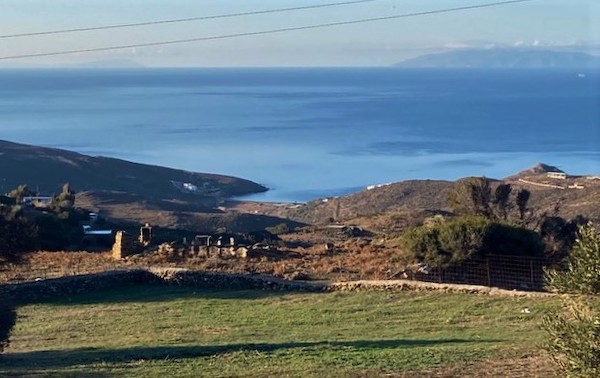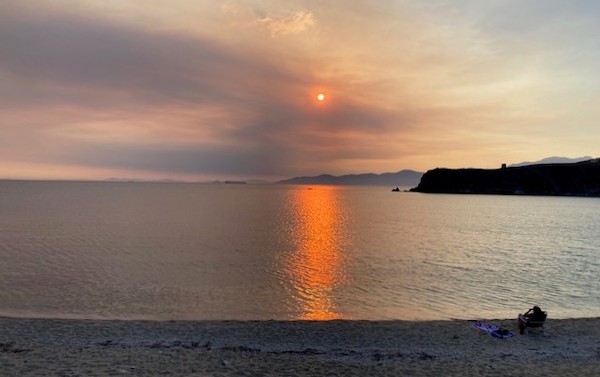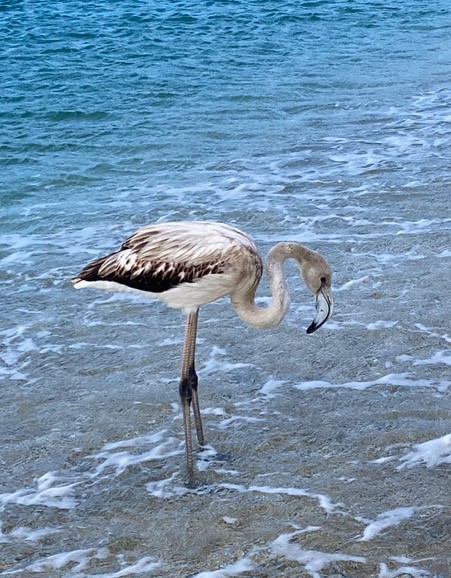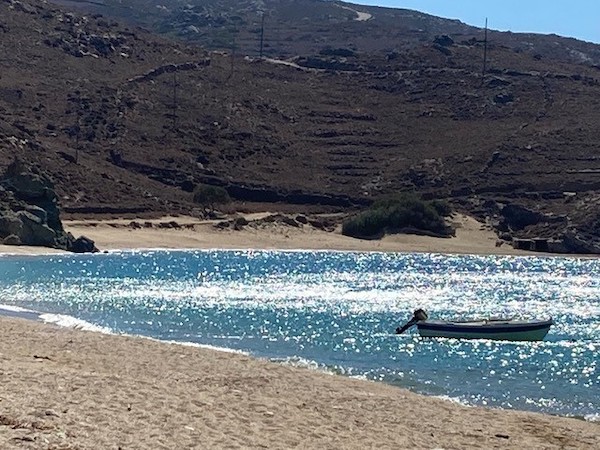Summer Memories for A Winter’s Day

“As the summer drew on, we became aware that we were living in a bubble, somehow protected from the disasters that seemed to be striking most parts of the world. Besides the unstoppable fires in the West of the US and Canada, floods were killing people and tearing towns in half in Germany, while a friend in London said that her street looked like the Grand Canal. Later, people would be drowning in New York City and New Jersey and the fires would destroy many of our beloved walks in Attica along with almost half of Evia, the island opposite Andros. The ash even reached our terrace, while for days ominous gray clouds streaked the horizon and the sun set in a surreal orange blur. At times, it was hotter inside the Arctic Circle than it was in Greece; though, at others, we had weeks of the worst heat anyone could remember.”—Diana Farr Louis
Eating Well Is The Best Revenge
By Diana Farr Louis

ATHENS Greece—(Weekly Hubris)—1 January 2022—Back in the Big Olive (after four and a half months in our island refuge on Andros), it’s hard to come to terms with gazing out on a panorama of different shades, shapes, and textures of green trees instead of a view that includes our olive trees, a camel-colored valley ending at a beach, the sea, and the hulks, sometimes blurry, sometimes clear, of three or four other Cycladic islands.
Even harder, though, is to look out the west window here and see nothing but apartment buildings, solar heaters, and TV antennas. And we consider ourselves lucky. Nothing close by rises as high as our third-floor windows. But I miss not being able to be outside, feasting my eyes on the changing skies and sea, grabbing a lemon or a basketful of figs or parting thorny branches to pry off a perfect pomegranate for breakfast.
I’m quite aware that I’m horribly spoiled. We had an almost normal summer. Especially in June and September/October. Beloved friends, some unseen for three years, others who came last summer, too, from the US and the UK, greeted us with hugs, parties, taverna lunches, and ouzos in cafés, while sometimes joining in our almost daily trips to delicious beaches.
It seemed quite unreal to be gathering without masks, to be touching, to be laughing, and telling stories of a winter that was so sad and lonely for so many people. One British friend, whose husband had died the previous September, said she hadn’t had as much social life in the past two years in England as she had in three weeks on Andros.
As the summer drew on, we became aware that we were living in a bubble, somehow protected from the disasters that seemed to be striking most parts of the world. Besides the unstoppable fires in the West of the US and Canada, floods were killing people and tearing towns in half in Germany, while a friend in London said that her street looked like the Grand Canal.
Later, people would be drowning in New York City and New Jersey and the fires would destroy many of our beloved walks in Attica along with almost half of Evia, the island opposite Andros. The ash even reached our terrace, while for days ominous gray clouds streaked the horizon and the sun set in a surreal orange blur. At times, it was hotter inside the Arctic Circle than it was in Greece; though, at others, we had weeks of the worst heat anyone could remember.

Our hillside was naturally cooler—even at 39.9°C (103.8°F) under the pergola—than the rest of the island and certainly much of the rest of Greece, but there was small comfort in the sea, where flotillas of stinging jellyfish lurked. Most of the time, our beaches were not as bad as those across the way on Kea or up north in Halkidiki, but I did manage to get lashed about four times, when I thought the sea was clear. Luckily, their sting is not even as bad as a bee’s, unpleasant but not too painful unless you happen to be allergic.
Come August, our normally quiet island turned into a tourist trap, attracting more visitors, Greek and foreign, than ever before, thanks to its proximity to the mainland but also to too many raves from well-known personalities. Melinda Stevens, the global editor of Conde Nast Traveller, who appears to have a house on the less glamorous (no shipowners, art museums, or yacht clubs) side of the island, actually stated in an interview in the June issue of Greek Vogue, that Andros was the most beautiful place in the world! Of course, it’s beautiful, but so are almost all the islands, and how can anywhere be the most anything in the world? Especially when beauty is so purely subjective.
To continue my grumble, the island’s popularity tipped it into a red Covid zone for a while and nearly resulted in a partial lockdown. But we survived by shopping at odd hours, eating at home, and sticking to our isolated beaches. Fortunately, August visitors are usually either employed or the parents of school-age kids, so as if with a magic wand, most of them vanished on the first of September and we breathed again.
But August (and September) also means figs, and our tree outdid itself this year, producing both black and green in such abundance that I found myself giving them away (this has never happened before), making chutney, cake, and even Corfiot sykomaida, an ancient recipe for figs kneaded to a paste with ouzo, fennel seeds, and nuts, spread out and left to dry in the sun, before being wrapped in fig leaves and saved for a winter snack. I made the mistake of storing them in a cookie tin and the first batch went irretrievably moldy. The second batch are safely in the fridge, to be doled out with utmost discretion.
October is when the pomegranates ripen, and our cantankerous tree also outdid itself, though its thorns made picking them an act of heroism. This bounty made up for having exactly six almonds from our seven trees and five fat olives from our 28 trees, which last year had produced more than ever before.

But besides a rash of birthday parties, September and early October bring clear skies and a sparkle to the water, compensating for the shorter days. One morning the glitter was so dense, it reminded me of tinsel. Another morning brought an even more incredible gift: a chance to communicate with a young flamingo, who must have been blown away from its flock (though I have to admit I was more interested in him than he in me). He let me get closer than we’re allowed to in shops and simply continued poking the sand for something to eat.
It is always a terrible wrench to pack up and leave our hermitage, not knowing when or even if we will be able to return. In this very unsettled and unsettling world of ours, we no longer make plans any further ahead than next week. But on the day before we left, a visit with a friend to a mountain village just 20 minutes from our houses added three more precious memories to my winter playbook.
First, we encountered the season’s very first cluster of cyclamen. They normally pop up in early September after the first rains, but this year it did not rain until early October. Second, we spotted the elephantine root and trunk of an otherworldly fig tree, while the third took us back to the Greece of 50 years ago.
Ammolochos is a village of springs and orchards, ghost mansions, and lush vegetation. We’d been eyeing trees laden with little apples (firikia, in Greek) and surrounded by windfalls, but fences kept us from poaching. Along came a man on a little motorbike. He greeted us in a friendly way, we exchanged a few platitudes, and off he went. Half an hour later as we were heading back to our car, he passed by again. This time, he had a bucket. “Have you got a bag? Care for some apples?” G always takes a bag on her walks, you never know—there might be fruit, cuttings to take, greens to pick. So, she unfolded it and our benefactor poured the entire contents of his bucket into it.
I was reminded of Nikos Kazantzakis’ quote from Report to Greco, “In Crete the stranger is still the unknown god. Before him all doors open and all hearts are opened.” But it’s not just true of Crete. You will still find this kind of spontaneous generosity all over Greece, one reason why I have never tired of living here.

Recipe
Unorthodox Moist Walnut Cake
For the holiday season, I propose a cake. This year, instead of or perhaps in addition to the Cretan raisin-nut cake I usually make for Christmas, I’m tempted by another from Feasting & Fasting in Crete. It’s called Unorthodox Moist Walnut Cake and some of its extra moisture comes from the fact that it contains no flour. If you used gluten-free breadcrumbs, too, this could be a wonderful treat for anyone who has celiac disease.
150 grams (⅔ cup) butter plus 1 tablespoon
80 grams (1 cup) dry breadcrumbs
650 grams (5 cups) chopped walnuts and a few walnut halves for decoration
1 teaspoon baking powder
1 teaspoon baking soda
1 teaspoon ground cinnamon
1 teaspoon grated nutmeg
200 grams (1 cup) sugar
4 eggs, well beaten
1 large apple, peeled and grated (save the peel)
60 ml (¼ cup) sweet red wine, preferably Mavrodaphne
60 ml (¼ cup) milk
2 teaspoons vanilla essence
1 tablespoon sesame seeds
Syrup
400 grams (2 cups) sugar
360 ml (1 ½ cups) water
6 cloves
piece of orange peel
apple peel
2 tablespoons honey
Preheat the oven to 200º C (400º F). Butter a round cake tin (26 cm/10 inches in diameter) and roll the breadcrumbs around it to coat the sides and bottom.
Mix together the walnuts, the rest of the breadcrumbs, the baking powder, baking soda, cinnamon, and the nutmeg. With an electric mixer beat the butter and sugar together until light and fluffy. Add the beaten eggs gradually, stirring in a little of the walnut mixture with each dose, with a wooden spoon.
Stir in the rest of the walnut mixture together with the apple, and slowly add the liquids, stirring all the while. Slide the mixture into the prepared baking pan, sprinkle with the sesame seeds, and decorate with halved walnuts. Bake for 20 minutes in a hot oven, lower the temperature to 190º C (375º F) and cook for a further 20 minutes.
To make the syrup boil the ingredients except for the honey for 10 minutes, stirring until the sugar melts. Then strain the syrup and stir in the honey, returning it to the heat until it dissolves.
Pour the hot syrup over the cooled cake and serve. This cake is so moist and scrumptious it can be eaten without the syrup. Serves 10.
![]()
To order the paperback book, click on the book cover below:

